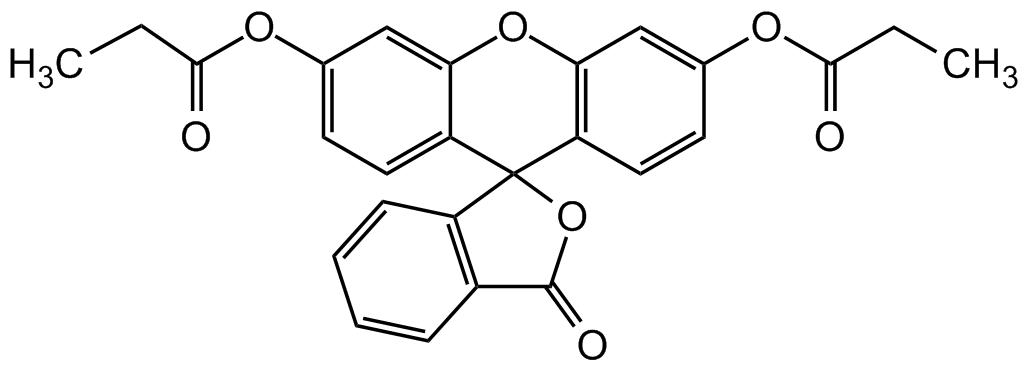Fluorescein dipropionate
| Code | Size | Price |
|---|
| CDX-F0088-G001 | 1 g | £255.00 |
Quantity:
Prices exclude any Taxes / VAT
Overview
Regulatory Status: RUO
Shipping:
AMBIENT
Storage:
+4°C
Images
Documents
Further Information
Alternate Names/Synonyms:
FDPr; 3',6'-Bis(1-oxopropoxy)spiro[isobenzofuran-1(3H),9'-[9H]xanthen]-3-one
Appearance:
Off-white powder.
CAS:
7276-28-0
EClass:
32160000
Form (Short):
solid
GHS Symbol:
GHS07
Handling Advice:
Protect from light and moisture.
Hazards:
H319
InChi:
InChI=1S/C26H20O7/c1-3-23(27)30-15-9-11-19-21(13-15)32-22-14-16(31-24(28)4-2)10-12-20(22)26(19)18-8-6-5-7-17(18)25(29)33-26/h5-14H,3-4H2,1-2H3
InChiKey:
NXIABCNYUKDBQI-UHFFFAOYSA-N
Long Description:
Chemical. CAS: 7276-28-0. Formula: C26H20O7. MW: 444.43. Fluorescein is the most important xanthene dye widely used for labeling and sensing biomolecules. It has a high extinction coefficient and fluorescence quantum yield in aqueous solution, and its excitation wavelength is in the visible range. However, fluorescein also has some obvious deficiencies. Particularly its hydrophilic nature limits its application to the detection of enzymes, therefore fluorescein esters are a useful alternative. Fluorescein esters, such as fluorescein dipropionate, are nonfluorescent, but they can be cleaved by intracellular enzymes to yield fluorescent products, such as fluorescein. The rate of change in the fluorescence of the solution, due to the production of fluorescein, is measured and correlated with enzyme activity. Therefore, fluorescein esters could be used as fluorometric determination probes of enzymes. Fluorescein dipropionate could also be used as a building block or intermediate in synthesis of fluorescent probes.
MDL:
MFCD00038598
Molecular Formula:
C26H20O7
Molecular Weight:
444.43
Package Type:
Vial
Precautions:
P264-P280-P305+P351+P338-P337+P313
Product Description:
Fluorescein is the most important xanthene dye widely used for labeling and sensing biomolecules. It has a high extinction coefficient and fluorescence quantum yield in aqueous solution, and its excitation wavelength is in the visible range. However, fluorescein also has some obvious deficiencies. Particularly its hydrophilic nature limits its application to the detection of enzymes, therefore fluorescein esters are a useful alternative. Fluorescein esters, such as fluorescein dipropionate, are nonfluorescent, but they can be cleaved by intracellular enzymes to yield fluorescent products, such as fluorescein. The rate of change in the fluorescence of the solution, due to the production of fluorescein, is measured and correlated with enzyme activity. Therefore, fluorescein esters could be used as fluorometric determination probes of enzymes. Fluorescein dipropionate could also be used as a building block or intermediate in synthesis of fluorescent probes.
Purity:
>97% (NMR)
Signal Word:
Warning
SMILES:
O=C(O1)C2=C(C=CC=C2)C31C4=CC=C(OC(CC)=O)C=C4OC5=C3C=CC(OC(CC)=O)=C5
Solubility Chemicals:
Soluble in ethanol or chloroform.
Source / Host:
Synthetic
Transportation:
Non-hazardous
UNSPSC Category:
Fluorescent Reagents
UNSPSC Number:
41105331
Use & Stability:
Stable for at least 2 years after receipt when stored at -20°C.
References
(1) B. Rotman & B.W. Papermaster; PNAS 55, 134 (1966) | (2) F.-Y. Ge, et al.; Dyes Pigments 72, 322 (2007) | (3) M. Poznik & B. Koenig; Org. Biomol. Chem. 12, 3175 (2014)



